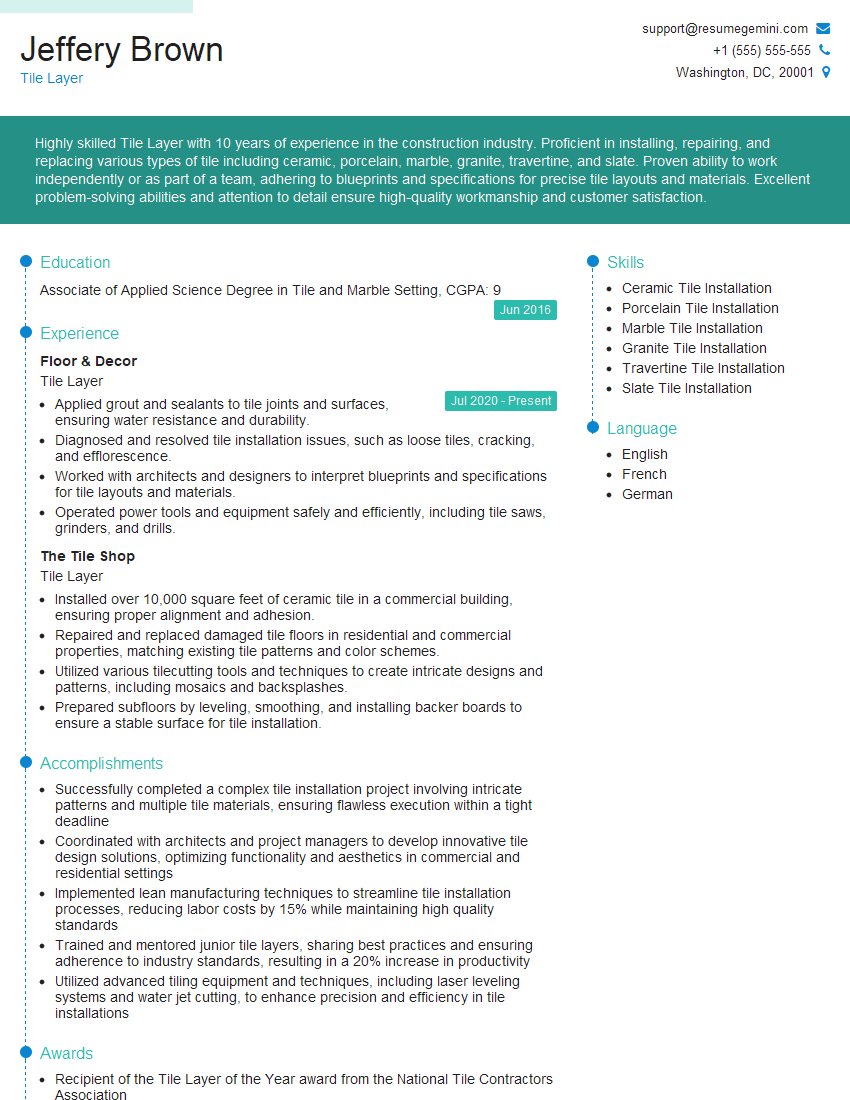Are you a seasoned Tile Layer seeking a new career path? Discover our professionally built Tile Layer Resume Template. This time-saving tool provides a solid foundation for your job search. Simply click “Edit Resume” to customize it with your unique experiences and achievements. Customize fonts and colors to match your personal style and increase your chances of landing your dream job. Explore more Resume Templates for additional options.

Jeffery Brown
Tile Layer
Summary
Highly skilled Tile Layer with 10 years of experience in the construction industry. Proficient in installing, repairing, and replacing various types of tile including ceramic, porcelain, marble, granite, travertine, and slate. Proven ability to work independently or as part of a team, adhering to blueprints and specifications for precise tile layouts and materials. Excellent problem-solving abilities and attention to detail ensure high-quality workmanship and customer satisfaction.
Education
Associate of Applied Science Degree in Tile and Marble Setting
June 2016
Skills
- Ceramic Tile Installation
- Porcelain Tile Installation
- Marble Tile Installation
- Granite Tile Installation
- Travertine Tile Installation
- Slate Tile Installation
Work Experience
Tile Layer
- Applied grout and sealants to tile joints and surfaces, ensuring water resistance and durability.
- Diagnosed and resolved tile installation issues, such as loose tiles, cracking, and efflorescence.
- Worked with architects and designers to interpret blueprints and specifications for tile layouts and materials.
- Operated power tools and equipment safely and efficiently, including tile saws, grinders, and drills.
Tile Layer
- Installed over 10,000 square feet of ceramic tile in a commercial building, ensuring proper alignment and adhesion.
- Repaired and replaced damaged tile floors in residential and commercial properties, matching existing tile patterns and color schemes.
- Utilized various tilecutting tools and techniques to create intricate designs and patterns, including mosaics and backsplashes.
- Prepared subfloors by leveling, smoothing, and installing backer boards to ensure a stable surface for tile installation.
Accomplishments
- Successfully completed a complex tile installation project involving intricate patterns and multiple tile materials, ensuring flawless execution within a tight deadline
- Coordinated with architects and project managers to develop innovative tile design solutions, optimizing functionality and aesthetics in commercial and residential settings
- Implemented lean manufacturing techniques to streamline tile installation processes, reducing labor costs by 15% while maintaining high quality standards
- Trained and mentored junior tile layers, sharing best practices and ensuring adherence to industry standards, resulting in a 20% increase in productivity
- Utilized advanced tiling equipment and techniques, including laser leveling systems and water jet cutting, to enhance precision and efficiency in tile installations
Awards
- Recipient of the Tile Layer of the Year award from the National Tile Contractors Association
- Recognized with the Golden Trowel Award for Outstanding Craftsmanship in Tile Installation
- Received the Master Tile Installer certification from the Ceramic Tile Education Foundation
Certificates
- Certified Tile Installer (CTI)
- National Tile Contractors Association (NTCA)
- Tile Council of North America (TCNA)
- American National Standards Institute (ANSI)
Career Expert Tips:
- Select the ideal resume template to showcase your professional experience effectively.
- Master the art of resume writing to highlight your unique qualifications and achievements.
- Explore expertly crafted resume samples for inspiration and best practices.
- Build your best resume for free this new year with ResumeGemini. Enjoy exclusive discounts on ATS optimized resume templates.
How To Write Resume For Tile Layer
- Highlight your experience and skills in installing various types of tile, including ceramic, porcelain, and natural stone.
- Showcase your knowledge of tile preparation techniques, such as subfloor preparation and backer board installation.
- Emphasize your ability to follow blueprints and specifications to ensure accurate tile placement and layout.
- Provide examples of complex or intricate tile projects you have completed, demonstrating your craftsmanship and attention to detail.
Essential Experience Highlights for a Strong Tile Layer Resume
- Installed over 10,000 square feet of ceramic tile in a commercial building, ensuring proper alignment and adhesion.
- Repaired and replaced damaged tile floors in residential and commercial properties, matching existing tile patterns and color schemes.
- Utilized various tile-cutting tools and techniques to create intricate designs and patterns, including mosaics and backsplashes.
- Prepared subfloors by leveling, smoothing, and installing backer boards to ensure a stable surface for tile installation.
- Applied grout and sealants to tile joints and surfaces, ensuring water resistance and durability.
- Diagnosed and resolved tile installation issues, such as loose tiles, cracking, and efflorescence.
- Collaborated with architects and designers to interpret blueprints and specifications for tile layouts and materials.
Frequently Asked Questions (FAQ’s) For Tile Layer
What are the different types of tile materials available?
Tile materials include ceramic, porcelain, marble, granite, travertine, and slate, each with unique properties and applications.
How do I prepare a subfloor for tile installation?
Subfloor preparation involves leveling, smoothing, and installing a backer board to create a stable and moisture-resistant base.
What are the common tile installation techniques?
Tile installation techniques include thin-set mortar, mastic, and self-leveling underlayment, depending on the tile type and subfloor conditions.
How do I grout and seal tile joints?
Grouting involves filling the joints between tiles with a cementitious material, while sealing protects the grout and tile surfaces from moisture and stains.
What are the common problems associated with tile installation?
Common tile installation problems include loose tiles, cracking, efflorescence, and improper grouting, which can be caused by various factors such as moisture, improper installation, or material defects.
How do I troubleshoot and repair tile installation issues?
Troubleshooting tile installation issues involves identifying the root cause, such as moisture penetration, loose tiles, or grout failure, and implementing appropriate repair techniques.